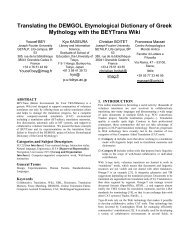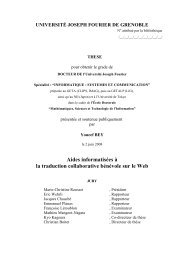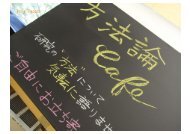Ability-Driven Education in Singapore
Ability-Driven Education in Singapore
Ability-Driven Education in Singapore
Create successful ePaper yourself
Turn your PDF publications into a flip-book with our unique Google optimized e-Paper software.
Christ<strong>in</strong>e Kim-Eng Lee<br />
National Institute of <strong>Education</strong><br />
ABILITY-DRIVEN EDUCATION<br />
IN SINGAPORE:<br />
RECENT REFORM<br />
INITIATIVES<br />
Christ<strong>in</strong>e Kim-Eng Lee<br />
National Institute of <strong>Education</strong>, S<strong>in</strong>gapore
Outl<strong>in</strong>e of Presentation<br />
• Brief about S<strong>in</strong>gapore and features of<br />
education system as cultural context<br />
• Historical perspective on educational<br />
developments and reforms<br />
• Current reforms <strong>in</strong> the context of abilitydriven<br />
education<br />
• Personal Observations/Reflections
SINGAPORE<br />
• Small country<br />
• Multiracial and multicultural<br />
• Meritocracy<br />
• Some national concerns - how to deal with<br />
competition from Ch<strong>in</strong>a, India and SEAsian<br />
neighbours; terrorism; globalisation.
Role of <strong>Education</strong><br />
<strong>in</strong> S<strong>in</strong>gapore<br />
• Nation-build<strong>in</strong>g<br />
• Economic Development<br />
• Social Cohesion<br />
Government Investment <strong>in</strong> <strong>Education</strong><br />
3.8% of GDP <strong>in</strong> 2003
<strong>Education</strong> System <strong>in</strong><br />
S<strong>in</strong>gapore<br />
• National school system<br />
• English as the medium of <strong>in</strong>struction<br />
• Common Curriculum for all schools<br />
• Primary <strong>Education</strong> – 6 years (178 pri schs)<br />
• Secondary <strong>Education</strong> – 4 years (165 sec schs)<br />
• Pre-University <strong>Education</strong> – 2 years (16JCs &<br />
2 CIs)
<strong>Education</strong>al Policy<br />
BILINGUALISM<br />
• Children learn English and learn their Mother-tongue<br />
language <strong>in</strong> school.<br />
• Results of the policy: Effectively a bil<strong>in</strong>gual society,<br />
after four decades of nationhood.<br />
• The 2000 census showed for the first time that a majority of<br />
the S<strong>in</strong>gapore population is now literate <strong>in</strong> two or more<br />
languages (56% <strong>in</strong> 2000 compared to 45% <strong>in</strong> 1990).<br />
• Among Ch<strong>in</strong>ese youths (aged 15-24), 88% are literate <strong>in</strong><br />
Mandar<strong>in</strong> and 98% <strong>in</strong> English.<br />
• Ref<strong>in</strong>ements to mother-tongue policy (2004)
<strong>Education</strong>al Policy<br />
STREAMING<br />
• Stream<strong>in</strong>g occurs at P4. Stream<strong>in</strong>g has been ref<strong>in</strong>ed<br />
recently to remove EM1 and EM2 dist<strong>in</strong>ction. EM 3<br />
rema<strong>in</strong>s.<br />
• High stakes exam<strong>in</strong>ations<br />
‣ PSLE which streamed children <strong>in</strong>to<br />
Special/Express/Normal Academic and Normal Technical<br />
Streams. More pressure on kids now to enter <strong>in</strong>tegrated<br />
programmes available <strong>in</strong> top secondary schools.<br />
‣ O level exam<strong>in</strong>ations - entry to pre-university, polytechnics<br />
and Institute of Technical <strong>Education</strong><br />
‣ A levels and Poly Diploma - entry to 3 universities.
Three Phases of<br />
<strong>Education</strong>al Developments<br />
• Survival-<strong>Driven</strong> <strong>Education</strong> (1959 – 1978)<br />
• Efficiency-<strong>Driven</strong> <strong>Education</strong> (1979 – 1996)<br />
• <strong>Ability</strong>-<strong>Driven</strong> <strong>Education</strong> (from 1997)
Survival-<strong>Driven</strong><br />
<strong>Education</strong><br />
• Response to Economic Survival<br />
• Mass <strong>Education</strong> with rapid rate of build<strong>in</strong>g of<br />
schools<br />
• Technical Bias <strong>in</strong> curriculum<br />
• Response to national cohesion<br />
• 4 vernacular schools and hence need to unify<br />
standards<br />
• Schools under a national system with a common<br />
curriculum
Efficiency-<strong>Driven</strong><br />
<strong>Education</strong><br />
• <strong>Ability</strong> stream<strong>in</strong>g <strong>in</strong>troduced<br />
• Stream<strong>in</strong>g at P3 <strong>in</strong>to normal, extended and<br />
monol<strong>in</strong>gual (revised to P4 and renamed EM1,EM2,<br />
EM3; further revised <strong>in</strong> 2004 to remove EM1 and<br />
EM2 dist<strong>in</strong>ction)<br />
• Stream<strong>in</strong>g at end of P6 <strong>in</strong>to Special, Express and<br />
Normal Streams <strong>in</strong> secondary schools<br />
• Curricular Changes<br />
• School Management<br />
• Emphasis on school reform with schools given greater<br />
autonomy
Effects of<br />
Efficiency-<strong>Driven</strong><br />
<strong>Education</strong><br />
• Reduction of educational wastage<br />
• Uniformity and standardisation<br />
• Narrow emphasis on academic<br />
achievement
“Th<strong>in</strong>k<strong>in</strong>g schools to be crucibles of<br />
question<strong>in</strong>g and search<strong>in</strong>g, with<strong>in</strong> and<br />
without the classroom ….and S<strong>in</strong>gapore a<br />
Learn<strong>in</strong>g Nation that goes beyond schools..”<br />
Prime M<strong>in</strong>ister Goh Chok Tong<br />
International Conference on Th<strong>in</strong>k<strong>in</strong>g, 2 July 1997
KEY THRUSTS OF TSLN<br />
• Emphasis on Critical and Creative Th<strong>in</strong>k<strong>in</strong>g<br />
• Use of Information Technology <strong>in</strong><br />
<strong>Education</strong><br />
• National <strong>Education</strong> (Citizenship <strong>Education</strong>)<br />
• Adm<strong>in</strong>istrative Excellence
THINKING SCHOOLS<br />
• Fundamental review of curriculum<br />
• Reduction of subject content<br />
• Revision of assessment mode<br />
• Greater emphasis on process <strong>in</strong>stead<br />
of outcomes e.g. <strong>in</strong>troduction of<br />
project work
Project Work<br />
allows students to:<br />
• Apply creative and critical<br />
th<strong>in</strong>k<strong>in</strong>g skills<br />
• Foster collaborative learn<strong>in</strong>g<br />
skills<br />
• Improve communication skills<br />
• Develop self-directed <strong>in</strong>quiry and<br />
life-long learn<strong>in</strong>g skills.
Infusion of IT <strong>in</strong> Schools<br />
IT MasterPlan<br />
• Pupil-Computer Ratio 2: 1<br />
• Teacher-Notebook Ratio 2:1<br />
• Whole School Network<strong>in</strong>g<br />
• 30% of curriculum time to be<br />
IT-based
National <strong>Education</strong><br />
The objective is to develop national cohesion, the<br />
<strong>in</strong>st<strong>in</strong>ct for survival and confidence <strong>in</strong> the future by<br />
• foster<strong>in</strong>g a sense of identity, pride and self-respect as<br />
S<strong>in</strong>gaporeans;<br />
• know<strong>in</strong>g the S<strong>in</strong>gapore story;<br />
• understand<strong>in</strong>g S<strong>in</strong>gapore’s unique challenges,<br />
constra<strong>in</strong>ts and vulnerabilites;<br />
• <strong>in</strong>still<strong>in</strong>g core values of our way of life.
TSLN heralds<br />
<strong>Ability</strong>-<strong>Driven</strong> <strong>Education</strong><br />
• Focus on develop<strong>in</strong>g the full spectrum of<br />
talents and abilities <strong>in</strong> each child through a<br />
mass customized approach to education<br />
• Focus on holistic education with greater<br />
emphasis on character rather than impart<strong>in</strong>g<br />
just knowledge and content.
KEY<br />
PRINCIPLES<br />
Improv<strong>in</strong>g Quality<br />
Increas<strong>in</strong>g Diversity<br />
Ma<strong>in</strong>ta<strong>in</strong><strong>in</strong>g Access
CURRICULUM REFORMS<br />
• Innovations <strong>in</strong> Pedagogy<br />
‣ Strategies for Effective Engagement and<br />
Development (SEED) & lower class size<br />
‣ Strategies for Active and Independent Learn<strong>in</strong>g<br />
(SAIL)<br />
‣ IT Innovations – Digital Literacy<br />
• Broaden<strong>in</strong>g of CCA framework (from 2004)<br />
• Changes <strong>in</strong> assessment – source-based<br />
questions; IB and NUS High school Diploma.<br />
• Revised JC Curriculum – K&I (<strong>in</strong> 2006)<br />
holistic<br />
qualitative
School Leaders and<br />
Teachers are the keys<br />
to success of<br />
education reforms<br />
Autonomy<br />
Quality
• Review of Teacher & <strong>Education</strong>al<br />
Leadership Programmes<br />
‣ Foundation Programmes<br />
‣ Diploma <strong>in</strong> Departmental Management & Leaders<br />
<strong>in</strong> <strong>Education</strong> Programmes<br />
• Professional Development of Teachers<br />
• New Career Tracks; New Recognition<br />
Structure; Work Attachment Scheme; 3000<br />
more teachers by 2010<br />
CONNECT<br />
EduPAC<br />
TEACHER ED<br />
REFORMS
My Observations<br />
& Reflections<br />
•Pace of Reform & Teacher<br />
Stress<br />
•Experimentation &<br />
failure/School Rank<strong>in</strong>g?<br />
•Elitism &Equity/Ethnicity
Christ<strong>in</strong>e Kim-Eng Lee<br />
National Institute of <strong>Education</strong><br />
Christ<strong>in</strong>e Kim-Eng Lee<br />
National Institute of <strong>Education</strong>, S<strong>in</strong>gapore







